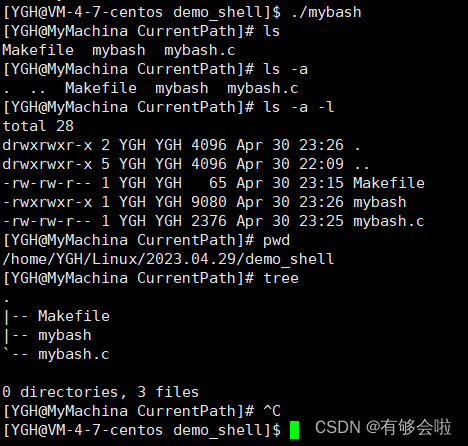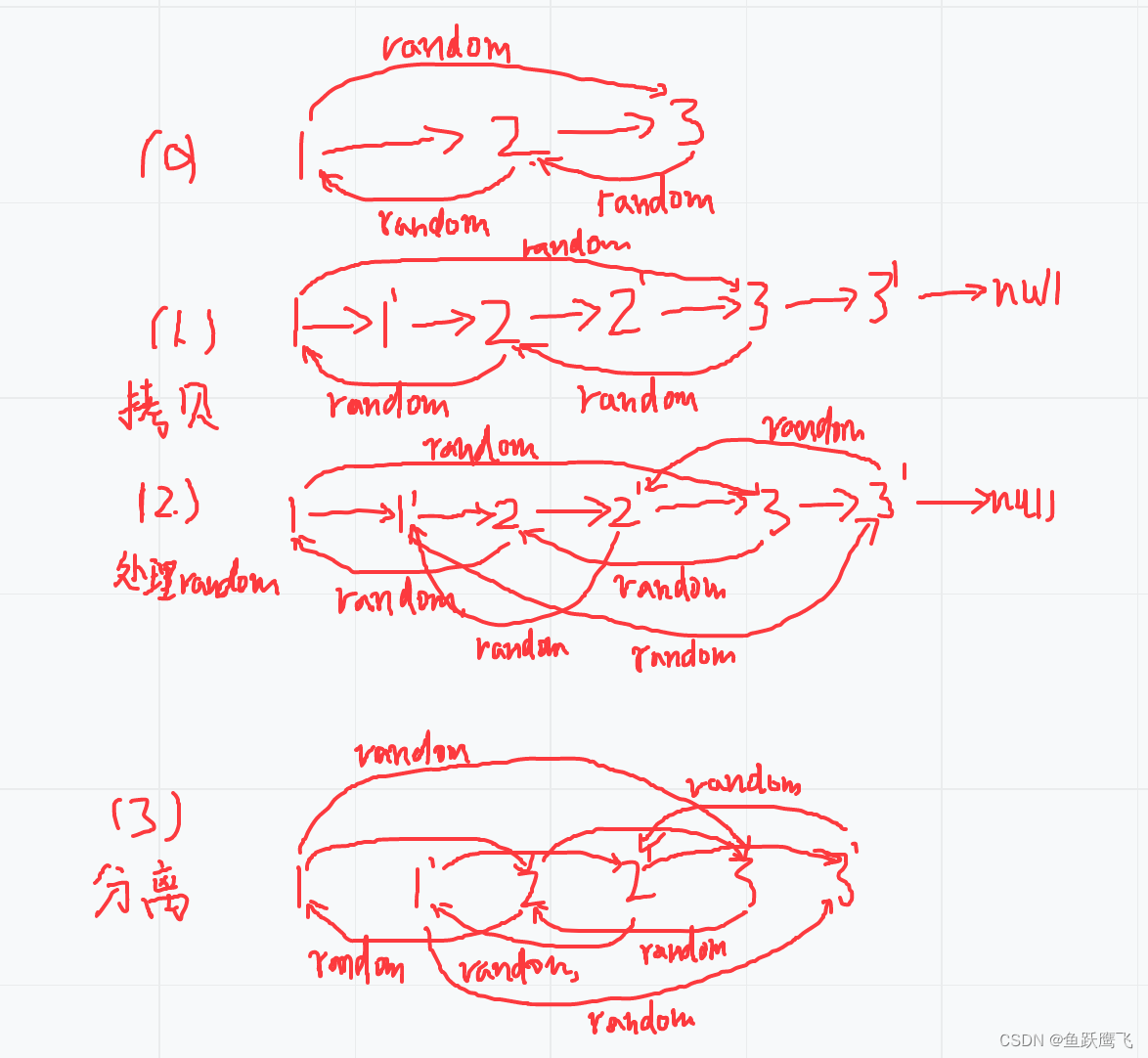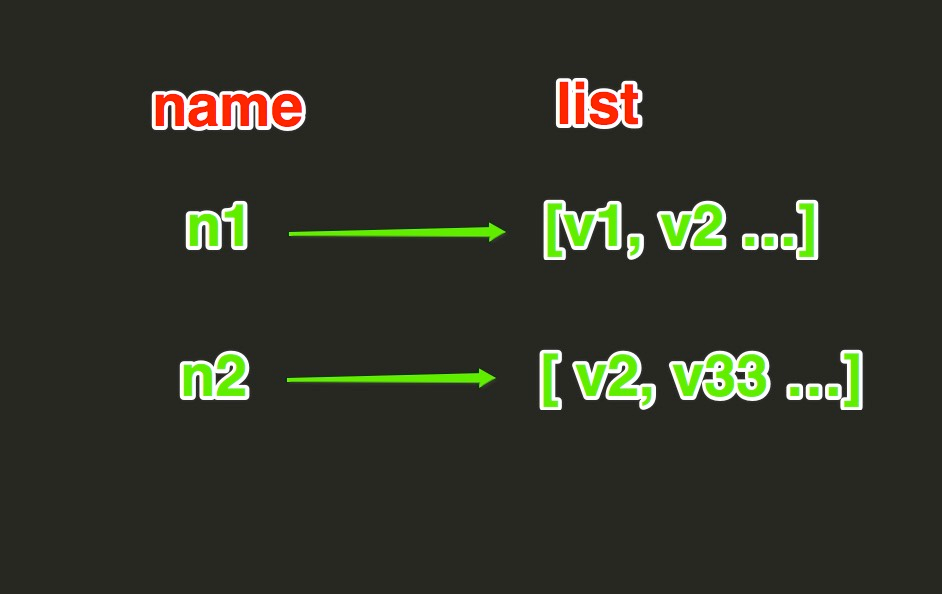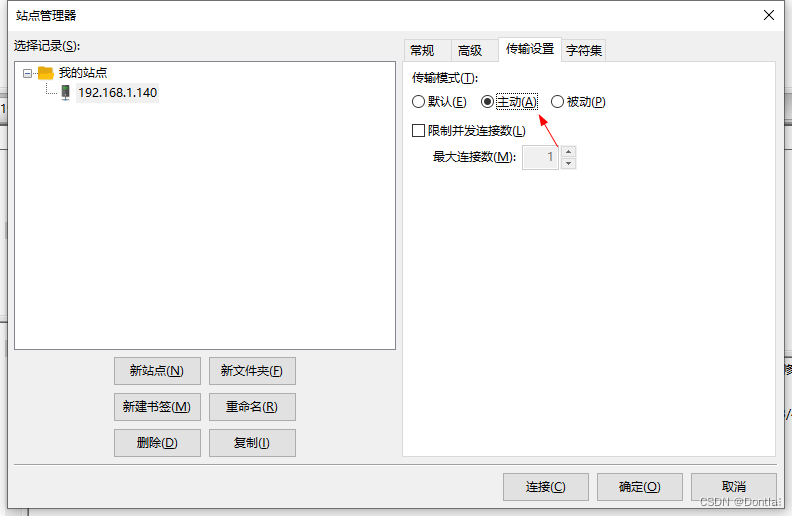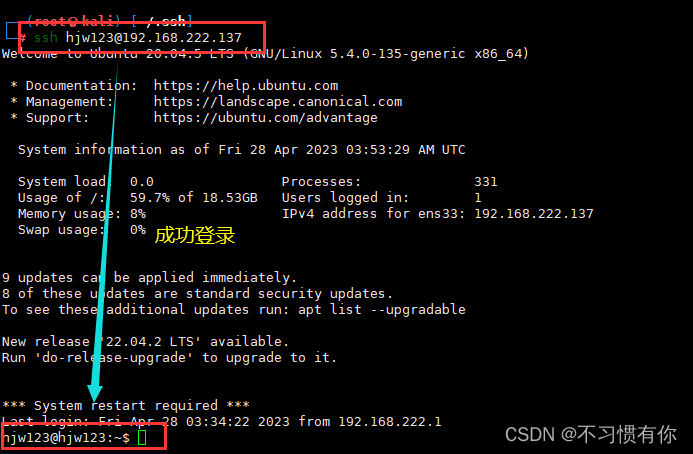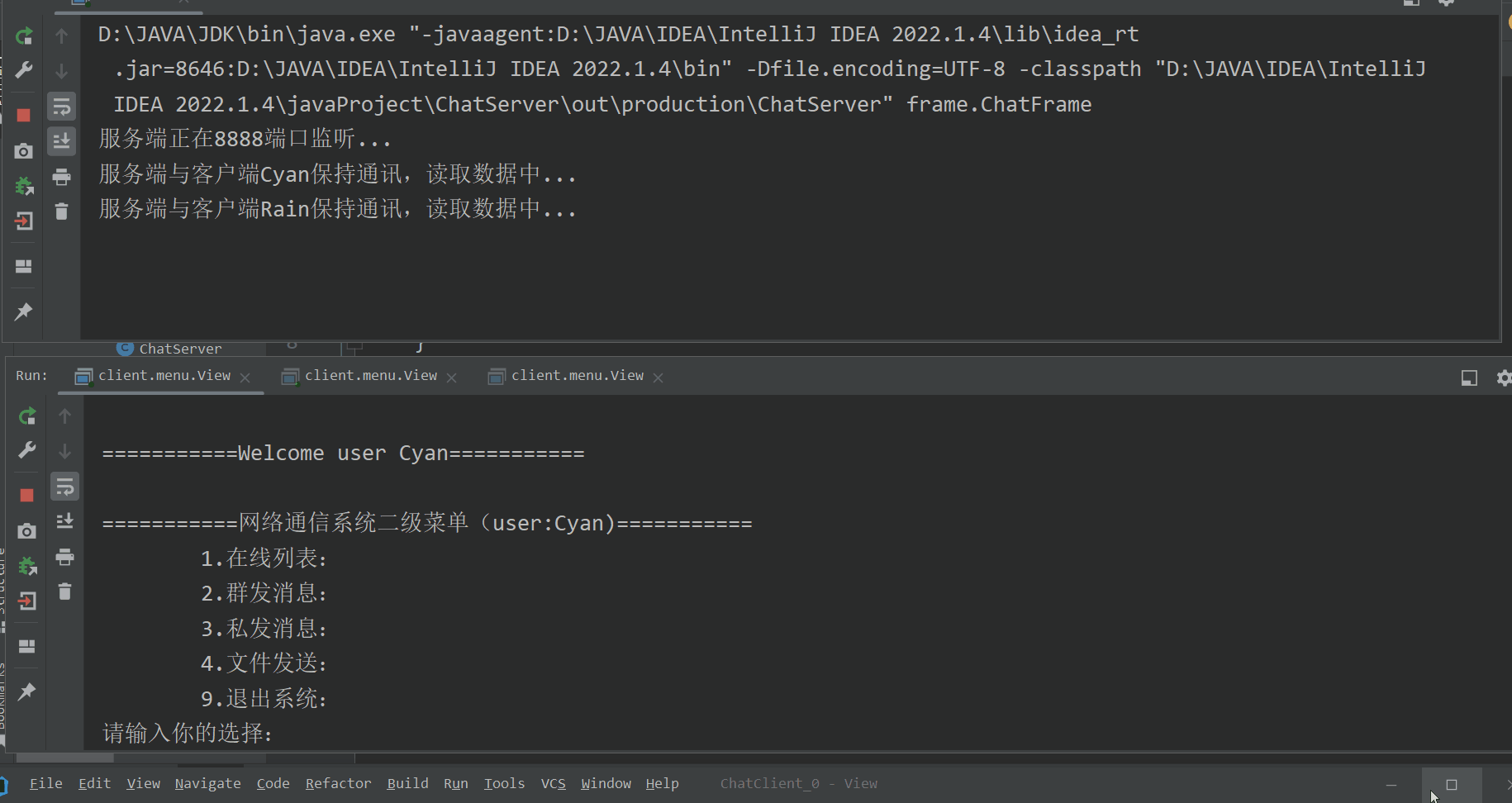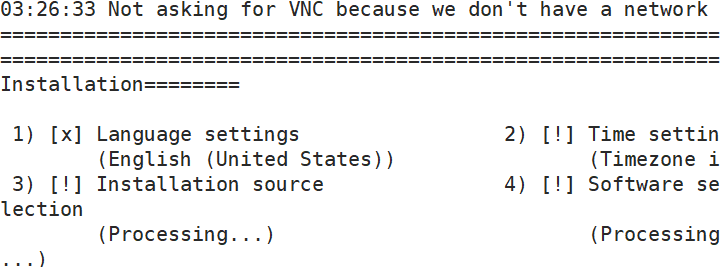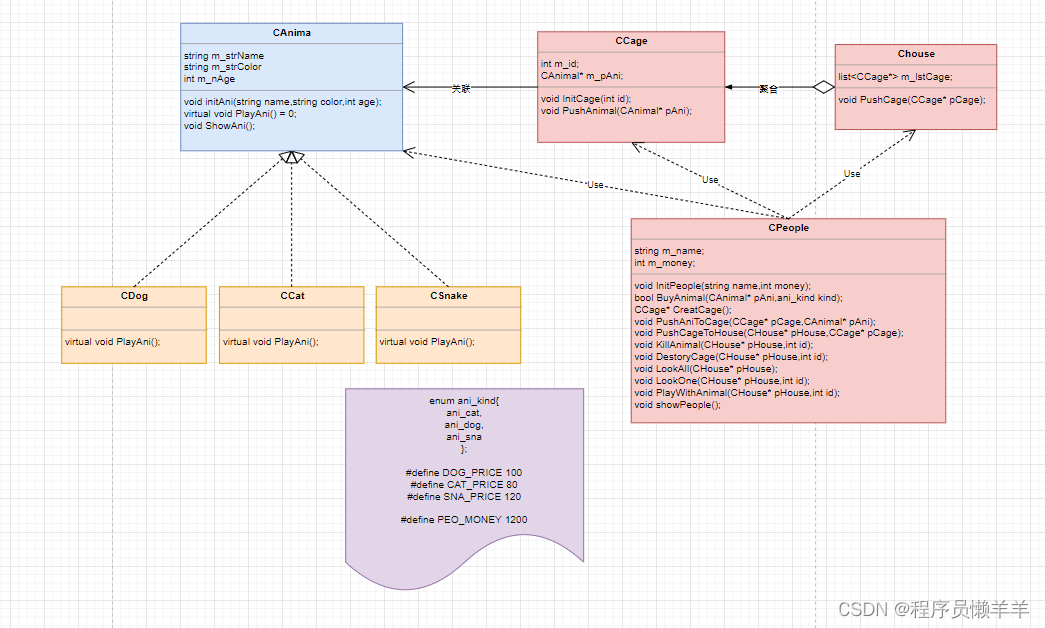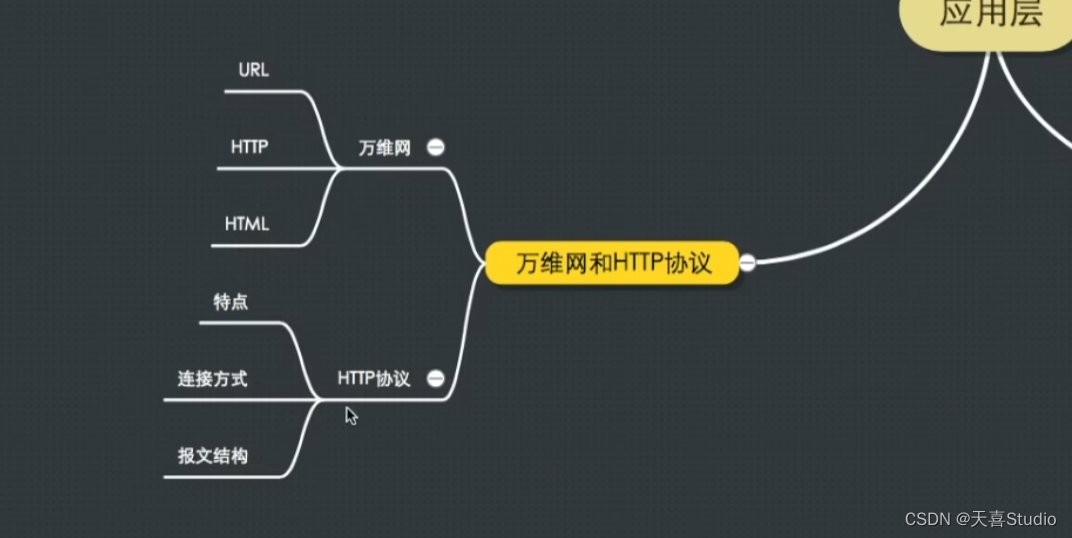目录
- 进程程序替换[1~5]
- 1.程序替换的接口(加载器)
- 2.什么是程序替换?
- 3.进程替换的原理
- 4.引入多进程
- 5.系列程序替换接口的详细解析(重点!)
- 自定义编写一个极简版shell[6~8]
- 6.完成命令行提示符
- 7.获取输入的命令行字符串
- 8.完整的代码与测试效果
进程程序替换[1~5]
创建子进程的目的是:
1.让子进程执行父进程的一部分代码;
2.让子进程执行一个全新的程序代码——进程的程序替换。
1.程序替换的接口(加载器)
程序替换的接口有:


(environ是环境变量表的指针,在环境变量讲过)
头文件:
#include <unistd.h>
函数:
int execl(const char *path, const char *arg, …);
int execlp(const char *file, const char *arg, …);
int execle(const char *path, const char *arg, …,char *const envp[]);
int execv(const char *path, char *const argv[]);
int execvp(const char *file, char *const argv[]);
int execve(const char *path, char *const argv[], char *const envp[]);
返回值:
调用成功,没有返回值;
调用出错,返回-1;(比如替换不存在的程序就会失败)
所以execl系列函数只有出错的返回值而没有成功的返回值;
即:只要有返回值,就失败了。
关于execl系列函数的使用:
因为这些程序替换函数如果替换成功,后面我们自己的程序就会被替换不再执行,会执行替换的程序。
所以我们一般不用对这些函数的返回值做判断,在使用完这些函数后,直接使用exit(1)退出就可以了,因为替换成功了不会执行退出函数,替换失败了就会执行exit(1)异常退出!
补充:
参数中的“…”表示的是可变参数列表,可变参数列表的作用是可以给函数传递任意个数个参数。
比如这个函数,前面两个指明的参数时必须传的,但是后面的参数可以不传,也可以任意个数去传。(其实与平时调用printf一样,逗号后面的参数需要多少个就传多少个)
2.什么是程序替换?
——用一段简单的代码来解释:
//测试代码
#include <stdio.h>
#include <stdlib.h>
#include <unistd.h>
int main()
{
printf("begin...\n");
printf("我是一个进程了,我的PID:%d\n", getpid());
execl("/bin/ls", "ls", "-a", "-l", NULL);
printf("end...\n");
}
结果:
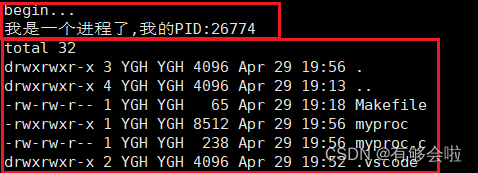
可以观察到,上面执行的是自己写的程序,后面执行的是ls命令。
ls是一个磁盘中的可执行程序,也就是一个文件,当我们自己的进程运行时,在内存中有自己的pcb和代码数据,刚开始执行的时候,执行的使我们自己的代码和数据,当执行execl时,就将磁盘中的ls可执行程序替换到当前进程的代码和数据中(main函数中老的代码和数据全都被替换了),所以后面执行的就不是我们自己的代码和数据了,执行的是替换后的ls的代码和数据,所以后面我们自己程序中的"end…"也没有打印出来。
3.进程替换的原理
在程序替换的时候,进程的数据和代码直接被新的程序所替换,如下图所示,并且直接换物理内存,左边的映射不变。
并且在进程替换的时候,并没有创建新的子进程,只是将当前的进程进行了替换,让CPU去调度当前进程就可以运行了,进程的内核pcb和虚拟地址空间都没有发生变化。
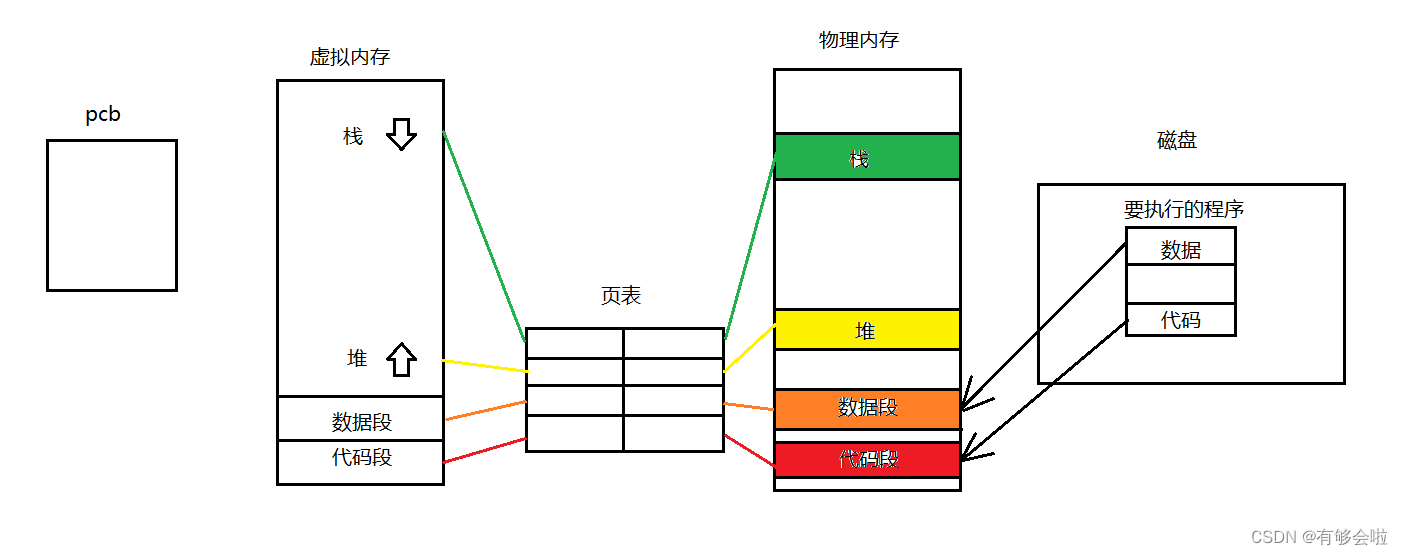
4.引入多进程
1.程序替换是整体替换,不能局部替换。
意思就是当前进程调用了程序替换接口,则当前进程全部的代码和数据都会被替换成新的。
2.程序替换只会影响调用的进程,因为进程具有独立性。
虽然父子进程通过页表指向同样的代码和数据,但是当子进程发生进程替换的时候,会发生写时拷贝,将父子进程进行区分,就不会影响父进程了。(代码区和数据区全都发生写时拷贝)
例如下面的代码:只替换子进程的程序:
#include <stdio.h>
#include <stdlib.h>
#include <unistd.h>
#include<sys/types.h>
#include <sys/wait.h>
int main()
{
pid_t id = fork();
if(id == 0)
{
printf("我是子进程:%d\n", getpid());
execl("/bin/ls", "ls", "-a", "-l", NULL);
//1.这里注释的是下面会替换失败的情况,这种情况父进程获取退出码为1
//execl("/bin/lssssss", "ls", "-a", "-l", NULL);
//2.这里注释的是下面会替换成功但是替换的程序内部出错的情况,这种情况父进程获取退出码为2
//execl("/bin/ls", "ls", "-abcdefg", "-l", NULL);
exit(1);
}
sleep(5);
int status = 0;
printf("我是父进程:%d\n", getpid());
waitpid(id, &status, 0);
printf("child exit code:%d\n", WEXITSTATUS(status));
return 0;
}
运行结果:
成功父子进程正常运行,子进程执行替换程序;
失败父子进程正常运行,子进程执行原有代码;
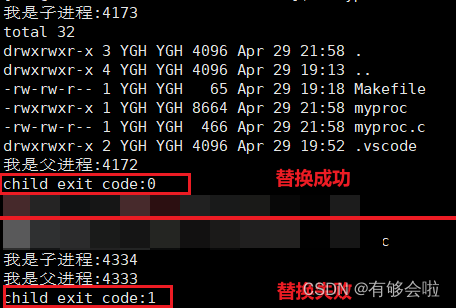
解析:
如果程序替换成功,则父进程waitpid获取到替换进程的退出码“0”;
如果程序替换失败,则父进程waitpid获取到原来进程的退出码“1”;
如果程序替换成功,但是替换成功的程序选项错误,这时的错误退出码也是由替换后的程序返回的,就比如前面代码中的成功但是退出码是2的情况。
5.系列程序替换接口的详细解析(重点!)
这些所有接口都符合前面所讲的性质,只是用法略有差异。
头文件:
#include <unistd.h>
函数:
int execl(const char *path, const char *arg, …);
int execlp(const char *file, const char *arg, …);
int execle(const char *path, const char *arg, …,char *const envp[]);
int execv(const char *path, char *const argv[]);
int execvp(const char *file, char *const argv[]);
int execve(const char *path, char *const argv[], char *const envp[]);
- int execl(const char *path, const char *arg, …) ——“l”表示list,以列表方式一个个传参。
path——想要执行程序的路径(比如ls,就传"/bin/ls");
arg——执行该程序的方式,(在命令行怎么执行就怎么传参,比如ls -a -l就传"ls", "-a", "-l")参数最后必须以NULL结尾;
例:execl("/bin/ls", "ls", "-a", "-l", NULL);
- int execv(const char *path, char *const argv[]) ——“v”表示vector,以数组方式一次性传参。
path——想要执行程序的路径(比如ls,就传"/bin/ls");
argv[]——传参以指针数组方式传(在命令行怎么执行数组中就怎么写,比如可以定义一个指针数组:char *myargv[] = {"ls", "-a", "-l", NULL};),传入的数组最后以NULL结尾;
例:
char *myargv[] = {"ls", "-l", "-a", NULL};
execv("/bin/ls", myargv);
- int execlp(const char *file, const char *arg, …) ——“p”表示环境变量PATH,会自动在PATH中查找。
file——想要执行的程序,不用带路径(比如ls,就传"ls");
arg——与execl的arg传入参数方式完全一样。(比如ls -a -l就传"ls", "-a", "-l");
例:execlp("ls", "ls", "-a", "-l", NULL);
4.int execvp(const char *file, char *const argv[]) ——“v”与“p”的意思和上面的一样。
file——想要执行的程序,不用带路径(比如ls,就传"ls");
argv[]——传参以指针数组方式传。(与execv一样);
例:execvp("ls", myargv);
- int execle(const char *path, const char *arg, …,char *const envp[]) ——父进程给子进程手动传环境变量。
path——想要执行程序的路径。
arg——执行该程序的方式,一个一个传入。
envp[]——自定义环境变量,以NULL结尾,比如:char *const myenv[] = {"MYENV=YouCanSeeMe", NULL};
解析:可以通过这些接口调用自己写好的其他可执行程序。(这些程序可以不是C程序,其他语言都可以调用)
例如:目录如下如所示,我们要通过myproc调用otherproc,并在otherproc中获取myproc传给它的环境变量MYENV。
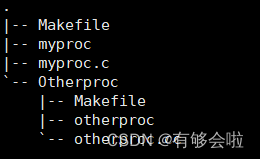
//myproc.c
#include <stdio.h>
#include <stdlib.h>
#include <unistd.h>
#include <sys/types.h>
#include <sys/wait.h>
int main()
{
pid_t id = fork();
if(id == 0)
{
printf("我是子进程:%d\n", getpid());
char *const myenv[] = {"MYENV=YouCanSeeMe", NULL};//自定义环境变量
execle("./Otherproc/otherproc", "otherproc", NULL, myenv);//传入自定义环境变量
exit(1);
}
sleep(5);
int status = 0;
printf("我是父进程:%d\n", getpid());
waitpid(id, &status, 0);
printf("child exit code:%d\n", WEXITSTATUS(status));
return 0;
}
//otherproc.cc
#include <iostream>
#include <unistd.h>
#include <stdlib.h>
#include <sys/types.h>
using namespace std;
int main()
{
for(int i = 0; i < 5; i++)
{
cout << "这是子进程, PID : " << getpid() << " MYENV : " << (getenv("MYENV")==NULL? "NULL" : getenv("MYENV")) << " PATH : " << (getenv("PATH")==NULL? "NULL" : getenv("PATH")) << endl;
sleep(1);
}
return 0;
}
运行结果:可以看到子进程获取了父进程传入的自定义环境变量。

注意:自定义环境变量envp是覆盖式传入,之前的老的会被覆盖!
如果我们想把父进程的环境变量原封不动的传给子进程,那么就用environ(之前讲过的获取环境变量的方法之一)传入即可。
用法:在父进程创建extern char **environ;后,直接传入。
比如:
#include <stdio.h>
#include <stdlib.h>
#include <unistd.h>
#include <sys/types.h>
#include <sys/wait.h>
int main()
{
extern char **environ;//获取父进程环境变量,下面通过execle传入
pid_t id = fork();
if(id == 0)
{
printf("我是子进程:%d\n", getpid());
execle("./Otherproc/otherproc", "otherproc", NULL, environ);
exit(1);
}
sleep(5);
int status = 0;
printf("我是父进程:%d\n", getpid());
waitpid(id, &status, 0);
printf("child exit code:%d\n", WEXITSTATUS(status));
return 0;
}
运行结果:发现子进程获取了父进程的默认环境变量PATH。

如果我们想保留原来父进程的环境变量,并且在此基础上增加自定义环境变量呢?
——int putenv(char *string);那个进程调用这个函数,就在当前的进程中新增一个环境变量。
头文件:#include <stdlib.h>。
#include <stdio.h>
#include <stdlib.h>
#include <unistd.h>
#include <sys/types.h>
#include <sys/wait.h>
int main()
{
extern char **environ;
pid_t id = fork();
if(id == 0)
{
printf("我是子进程:%d\n", getpid());
putenv("MYENV=YouCanSeeMe");
execle("./Otherproc/otherproc", "otherproc", NULL, environ);
exit(1);
}
sleep(5);
int status = 0;
printf("我是父进程:%d\n", getpid());
waitpid(id, &status, 0);
printf("child exit code:%d\n", WEXITSTATUS(status));
return 0;
}
我们的子进程otherproc默认继承的是父进程proc的环境变量,那么父进程的环境变量从哪里来?
——bash,所以我们也可以不用putenv来追加环境变量,直接在命令行输入export MYENV=YouCanSeeMe,来给bash添加一个环境变量,这样默认传入environ的时候子进程也会接收到MYENV这个环境变量了。
- int execve(const char *path, char *const argv[], char *const envp[]);
发现这个接口在man手册中被单独放出来了,和前面的有什么区别?
——接口用法的规则和前面的几个一模一样,类推即可不再详细解析。
那么区别是:这个是真正提供的的系统调用接口,上面的所有都是对这个的封装!
自定义编写一个极简版shell[6~8]
bash就是一个进程:

6.完成命令行提示符
bash会接收我们输入的命令行字符串,并且不会退出,一直在为我们打印命令行提示符。
一个命令行提示符包括:
[用户名 + @ + 主机名 + 当前路径的名称]$
每个字段都可以通过对应的系统调用获取,但是现在对我来说意义不大,这里直接打印,就不使用了。
//实现命令行提示符:
int main()
{
while(1)
{
printf("[YGH@MyMachina CurrentPath]#");//命令行的输入是在当前行输入,不能用\n
fflush(stdout);//不用\n不会行刷新出来,所以要用fflush刷新缓冲区
sleep(100);//测试观察,这句之后不要
}
}
7.获取输入的命令行字符串
使用接口fget——从特定的标准输入stream当中获取命令行输入。
接口函数:char *fgets(char *s, int size, FILE *stream);
头文件:stdio.h
手册查询:
1.首先我们自己定一个一个命令行commandstr,然后通过fgets获取输入的命令行字符串:
#include <stdio.h>
#include <string.h>
#include <unistd.h>
#include <assert.h>
#define MAX 1024
int main()
{
char commandstr[MAX] = {0};
while(1)
{
printf("[YGH@MyMachina CurrentPath]# ");//命令行的输入是在当前行输入,不能用\n
fflush(stdout);//不用\n不会行刷新出来,所以要用fflush刷新缓冲区
char *s = fgets(commandstr, sizeof(commandstr), stdin);//输入的时候最后缓冲区会输入一个\n
assert(s);//断言在debug方式的时候存在,release方式会被裁掉
(void)s;//这句的用处是让断言在release方式下也不会失效(因为assert被去掉了,s没有被使用会报警,这里用一下就不会报警了)
commandstr[strlen(commandstr) - 1] = '\0';//去掉我们缓冲区中输入的\n
printf("%s\n", commandstr);//测试观察一下,这句之后不要
}
}
2.然后我们也不能自己来执行命令行输入要执行的程序,因为如果进程替换了我们作为命令行自己就会被替换掉了,这样是不合理的,所以肯定需要子进程来处理。
即父进程把命令给子进程,然后父进程等待结果就行了。
同时我们的自定义缓冲区中输入的是一整个连续的字符串,需要切割成单个的命令传入,比如:“ls -a -l” 要切割成: “ls”, “-a”, “-l”。
——可以自己切割,也可以使用字符串分割函数:char* strtok(char* str, const char* sep);
进行字符串的切割:
#include <stdio.h>
#include <string.h>
#include <unistd.h>
#include <stdlib.h>
#include <assert.h>
#include <sys/types.h>
#include <sys/wait.h>
#define MAX 1024
#define ARGC 64
#define SEP " "//分隔符空格
//字符串切割函数
int split(char* commandstr, char* argv[])
{
assert(commandstr);
assert(argv);
argv[0] = strtok(commandstr, SEP);//函数切割后返回第一个地址
if(argv[0] == NULL)
{
return 1;
}
int i = 1;
while(argv[i++] = strtok(NULL, SEP));//这一句等价于下面的一段代码
//while(1)
//{
// argv[i] = strtok(NULL, SEP);//NULL表示还是继续切割commandstr
// if(argv[i] == NULL)
// {
// break;
// }
// i++;
//}
return 0;
}
int main()
{
while(1)
{
char commandstr[MAX] = {0};//放在循环内部每次输入后重新创建缓冲区判断
char* argv[ARGC] = {NULL};//存放切割后的字符串
printf("[YGH@MyMachina CurrentPath]# ");//命令行的输入是在当前行输入,不能用\n
fflush(stdout);//不用\n不会行刷新出来,所以要用fflush刷新缓冲区
char *s = fgets(commandstr, sizeof(commandstr), stdin);//输入的时候最后缓冲区会输入一个\n
assert(s);//断言在debug方式的时候存在,release方式会被裁掉
(void)s;//这句的用处是让断言在release方式下也不会失效(因为assert被去掉了,s没有被使用会报警,这里用一下就不会报警了)
commandstr[strlen(commandstr) - 1] = '\0';//去掉我们缓冲区中输入的\n
int n = split(commandstr, argv);//字符串切割
if(n != 0)//判断字符串是否切割成功
{
continue;
}
pid_t id = fork();
assert(id >= 0);
(void)id;
if(id == 0)
{
//子进程
exit(0);
}
//父进程
int status = 0;//退出码
waitpid(id, &status, 0);//阻塞等待子进程
}
}
完成切割后进行进程的替换:要使用execvp,因为输入的命令没有地址,要在环境变量中直接寻找,需要“p”,而且输入的命令行字符串时切割开放在一个数组中的,所以需要“v”。
#include <stdio.h>
#include <string.h>
#include <unistd.h>
#include <stdlib.h>
#include <assert.h>
#include <sys/types.h>
#include <sys/wait.h>
#define MAX 1024
#define ARGC 64
#define SEP " "//分隔符空格
//字符串切割函数
int split(char* commandstr, char* argv[])
{
assert(commandstr);
assert(argv);
argv[0] = strtok(commandstr, SEP);//函数切割后返回第一个地址
if(argv[0] == NULL)
{
return 1;
}
int i = 1;
while(argv[i++] = strtok(NULL, SEP));//这一句等价于下面的一段代码
//while(1)
//{
// argv[i] = strtok(NULL, SEP);//NULL表示还是继续切割commandstr
// if(argv[i] == NULL)
// {
// break;
// }
// i++;
//}
return 0;
}
//用来输出切割后的字符串的函数
void debugPrintf(char* argv[])
{
for(int i = 0; argv[i]; i++)
{
printf("%d: %s\n", i, argv[i]);
}
}
int main()
{
while(1)
{
char commandstr[MAX] = {0};//放在循环内部每次输入后重新创建缓冲区判断
char* argv[ARGC] = {NULL};//存放切割后的字符串
printf("[YGH@MyMachina CurrentPath]# ");//命令行的输入是在当前行输入,不能用\n
fflush(stdout);//不用\n不会行刷新出来,所以要用fflush刷新缓冲区
char *s = fgets(commandstr, sizeof(commandstr), stdin);//输入的时候最后缓冲区会输入一个\n
assert(s);//断言在debug方式的时候存在,release方式会被裁掉
(void)s;//这句的用处是让断言在release方式下也不会失效(因为assert被去掉了,s没有被使用会报警,这里用一下就不会报警了)
commandstr[strlen(commandstr) - 1] = '\0';//去掉我们缓冲区中输入的\n
int n = split(commandstr, argv);//字符串切割
if(n != 0)//判断字符串是否切割成功
{
continue;
}
//debugPrintf(argv);//测试输出切割后的字符串
pid_t id = fork();
assert(id >= 0);
(void)id;
if(id == 0)
{
//子进程
execvp(argv[0], argv);
exit(1);//替换失败直接退出
}
//父进程
int status = 0;//退出码
waitpid(id, &status, 0);//阻塞等待子进程
}
}
8.完整的代码与测试效果
以上就实现了一个最基础的极简版的shell命令行,以下是删除不必要的完整代码:
#include <stdio.h>
#include <string.h>
#include <unistd.h>
#include <stdlib.h>
#include <assert.h>
#include <sys/types.h>
#include <sys/wait.h>
#define MAX 1024
#define ARGC 64
#define SEP " "//分隔符空格
//字符串切割函数
int split(char* commandstr, char* argv[])
{
assert(commandstr);
assert(argv);
argv[0] = strtok(commandstr, SEP);//函数切割后返回第一个地址
if(argv[0] == NULL)
{
return 1;
}
int i = 1;
while(argv[i++] = strtok(NULL, SEP));//这一句等价于下面的一段代码
return 0;
}
int main()
{
while(1)
{
char commandstr[MAX] = {0};//放在循环内部每次输入后重新创建缓冲区判断
char* argv[ARGC] = {NULL};//存放切割后的字符串
printf("[YGH@MyMachina CurrentPath]# ");//命令行的输入是在当前行输入,不能用\n
fflush(stdout);//不用\n不会行刷新出来,所以要用fflush刷新缓冲区
char *s = fgets(commandstr, sizeof(commandstr), stdin);//输入的时候最后缓冲区会输入一个\n
assert(s);//断言在debug方式的时候存在,release方式会被裁掉
(void)s;//这句的用处是让断言在release方式下也不会失效(因为assert被去掉了,s没有被使用会报警,这里用一下就不会报警了)
commandstr[strlen(commandstr) - 1] = '\0';//去掉我们缓冲区中输入的\n
int n = split(commandstr, argv);//字符串切割
if(n != 0)//判断字符串是否切割成功
{
continue;
}
pid_t id = fork();
assert(id >= 0);
(void)id;
if(id == 0)
{
//子进程
execvp(argv[0], argv);
exit(1);//替换失败直接退出
}
//父进程
int status = 0;//退出码
waitpid(id, &status, 0);//阻塞等待子进程
}
}
测试效果:
